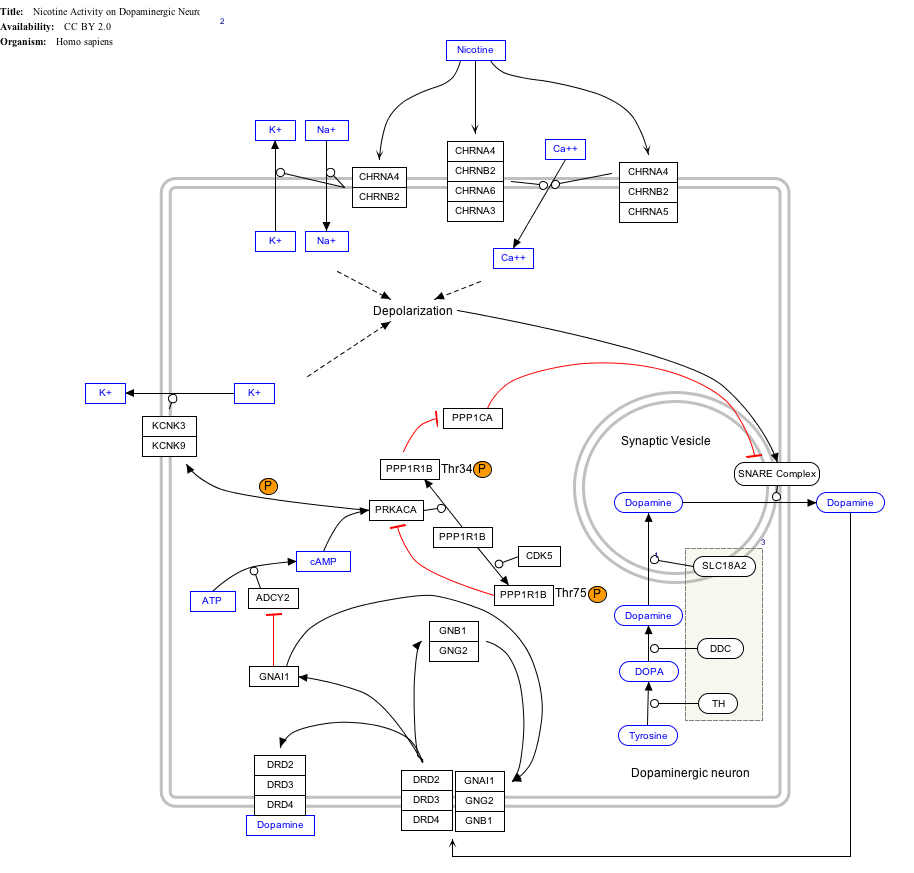CHRNA6
| Cholinergic receptor, nicotinic, alpha 6 (neuronal) | |||||||||||||
|---|---|---|---|---|---|---|---|---|---|---|---|---|---|
| Identifiers | |||||||||||||
| Symbols | CHRNA6; CHNRA6 | ||||||||||||
| External IDs | OMIM: 606888 MGI: 106213 HomoloGene: 20888 IUPHAR: α6 ChEMBL: 2356 GeneCards: CHRNA6 Gene | ||||||||||||
| |||||||||||||
| RNA expression pattern | |||||||||||||
 | |||||||||||||
| More reference expression data | |||||||||||||
| Orthologs | |||||||||||||
| Species | Human | Mouse | |||||||||||
| Entrez | 8973 | 11440 | |||||||||||
| Ensembl | ENSG00000147434 | ENSMUSG00000031491 | |||||||||||
| UniProt | Q15825 | Q9R0W9 | |||||||||||
| RefSeq (mRNA) | NM_001199279 | NM_021369 | |||||||||||
| RefSeq (protein) | NP_001186208 | NP_067344 | |||||||||||
| Location (UCSC) | Chr 8: 42.61 – 42.65 Mb | Chr 8: 27.4 – 27.41 Mb | |||||||||||
| PubMed search | |||||||||||||
Cholinergic receptor, nicotinic, alpha 6, also known as CHRNA6, is a human gene,[1] which codes for the α6 subunit found in certain types of nicotinic acetylcholine receptors found primarily in the brain. Neural nicotinic acetylcholine receptors containing α6 subunits are expressed on dopamine-releasing neurons in the midbrain,[2] and dopamine release following activation of these neurons is thought to be involved in the addictive properties of nicotine.[3][4][5] Due to their selective localisation on dopaminergic neurons, α6-containing nACh receptors have also been suggested as a possible therapeutic target for the treatment of Parkinson's disease.[6][7]
Interactive pathway map
Click on genes, proteins and metabolites below to link to respective articles. [§ 1]
- ↑ The interactive pathway map can be edited at WikiPathways: "NicotineDopaminergic_WP1602".
See also
References
- ↑ "Entrez Gene: CHRNA6 cholinergic receptor, nicotinic, alpha 6".
- ↑ Meyer, EL, Yoshikami, D, McIntosh, JM (2008). "The Neuronal Nicotinic Acetylcholine Receptors α4* and α6* Differentially Modulate Dopamine Release in Mouse Striatal Slices". Journal of Neurochemistry 105 (5): 1761–9. doi:10.1111/j.1471-4159.2008.05266.x. PMC 2527994. PMID 18248619.
- ↑ Calabresi, P, Massimiliano, DF. (Oct 2008). "ACh/Dopamine Crosstalk in Motor Control and Reward: A Crucial Role for α6-Containing Nicotinic Receptors?". Neuron 60 (1): 4–7. doi:10.1016/j.neuron.2008.09.031. PMID 18940582.
- ↑ Drenan, RM; Grady, SR; Whiteaker, P; McClure-Begley, T; McKinney, S; Miwa, JM; Bupp, S; Heintz, N et al. (Oct 2008). "In Vivo Activation of Midbrain Dopamine Neurons via Sensitized, High-Affinity α6* Nicotinic Acetylcholine Receptors". Neuron 60 (1): 123–136. doi:10.1016/j.neuron.2008.09.009. PMC 2632732. PMID 18940593.
- ↑ Exley, R, Clements, MA, Hartung, H, McIntosh, JM, Cragg, SJ (2008). "Alpha6-containing nicotinic acetylcholine receptors dominate the nicotine control of dopamine neurotransmission in nucleus accumbens". Neuropsychopharmacology 33 (9): 2158–66. doi:10.1038/sj.npp.1301617. PMID 18033235.
- ↑ Quik, M, McIntosh, JM (2006). "Striatal alpha6* nicotinic acetylcholine receptors: potential targets for Parkinson's disease therapy". The Journal of Pharmacology and Experimental Therapeutics 316 (2): 481–9. doi:10.1124/jpet.105.094375. PMID 16210393.
- ↑ Bordia, T, Grady, SR, McIntosh, JM, Quik, M (2007). "Nigrostriatal damage preferentially decreases a subpopulation of alpha6beta2* nAChRs in mouse, monkey, and Parkinson's disease striatum". Molecular Pharmacology 72 (1): 52–61. doi:10.1124/mol.107.035998. PMID 17409284.
Further reading
- Zeiger JS, Haberstick BC, Schlaepfer I, et al. (2008). "The neuronal nicotinic receptor subunit genes (CHRNA6 and CHRNB3) are associated with subjective responses to tobacco". Hum. Mol. Genet. 17 (5): 724–34. doi:10.1093/hmg/ddm344. PMID 18055561.
- Shi J, Hattori E, Zou H, et al. (2007). "No Evidence for Association between 19 Cholinergic Genes and Bipolar Disorder". Am. J. Med. Genet. B Neuropsychiatr. Genet. 144 (6): 715–23. doi:10.1002/ajmg.b.30417. PMC 2576477. PMID 17373692.
- Olsen JV, Blagoev B, Gnad F, et al. (2006). "Global, in vivo, and site-specific phosphorylation dynamics in signaling networks". Cell 127 (3): 635–48. doi:10.1016/j.cell.2006.09.026. PMID 17081983.
- Gerhard DS, Wagner L, Feingold EA, et al. (2004). "The Status, Quality, and Expansion of the NIH Full-Length cDNA Project: The Mammalian Gene Collection (MGC)". Genome Res. 14 (10B): 2121–7. doi:10.1101/gr.2596504. PMC 528928. PMID 15489334.
- Keiger CJ, Case LD, Kendal-Reed M, et al. (2003). "Nicotinic cholinergic receptor expression in the human nasal mucosa". Ann. Otol. Rhinol. Laryngol. 112 (1): 77–84. PMID 12537063.
- Strausberg RL, Feingold EA, Grouse LH, et al. (2003). "Generation and initial analysis of more than 15,000 full-length human and mouse cDNA sequences". Proc. Natl. Acad. Sci. U.S.A. 99 (26): 16899–903. doi:10.1073/pnas.242603899. PMC 139241. PMID 12477932.
- Ebihara M, Ohba H, Ohno SI, Yoshikawa T (2003). "Genomic organization and promoter analysis of the human nicotinic acetylcholine receptor alpha6 subunit (CHNRA6) gene: Alu and other elements direct transcriptional repression". Gene 298 (1): 101–8. doi:10.1016/S0378-1119(02)00925-3. PMID 12406580.
- Graham A, Court JA, Martin-Ruiz CM, et al. (2002). "Immunohistochemical localisation of nicotinic acetylcholine receptor subunits in human cerebellum". Neuroscience 113 (3): 493–507. doi:10.1016/S0306-4522(02)00223-3. PMID 12150770.
- Le Novère N, Zoli M, Changeux JP (1997). "Neuronal nicotinic receptor alpha 6 subunit mRNA is selectively concentrated in catecholaminergic nuclei of the rat brain". Eur. J. Neurosci. 8 (11): 2428–39. doi:10.1111/j.1460-9568.1996.tb01206.x. PMID 8950106.
- Elliott KJ, Ellis SB, Berckhan KJ, et al. (1997). "Comparative structure of human neuronal alpha 2-alpha 7 and beta 2-beta 4 nicotinic acetylcholine receptor subunits and functional expression of the alpha 2, alpha 3, alpha 4, alpha 7, beta 2, and beta 4 subunits". J. Mol. Neurosci. 7 (3): 217–28. doi:10.1007/BF02736842. PMID 8906617.
External links
- CHRNA6 protein, human at the US National Library of Medicine Medical Subject Headings (MeSH)
This article incorporates text from the United States National Library of Medicine, which is in the public domain.
| ||||||||||||||||||||||||||||||||||||||
